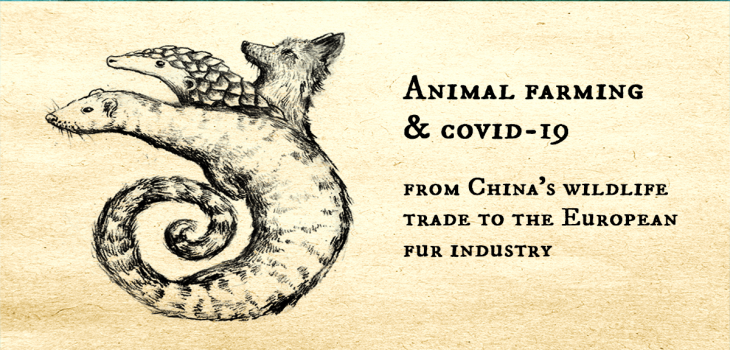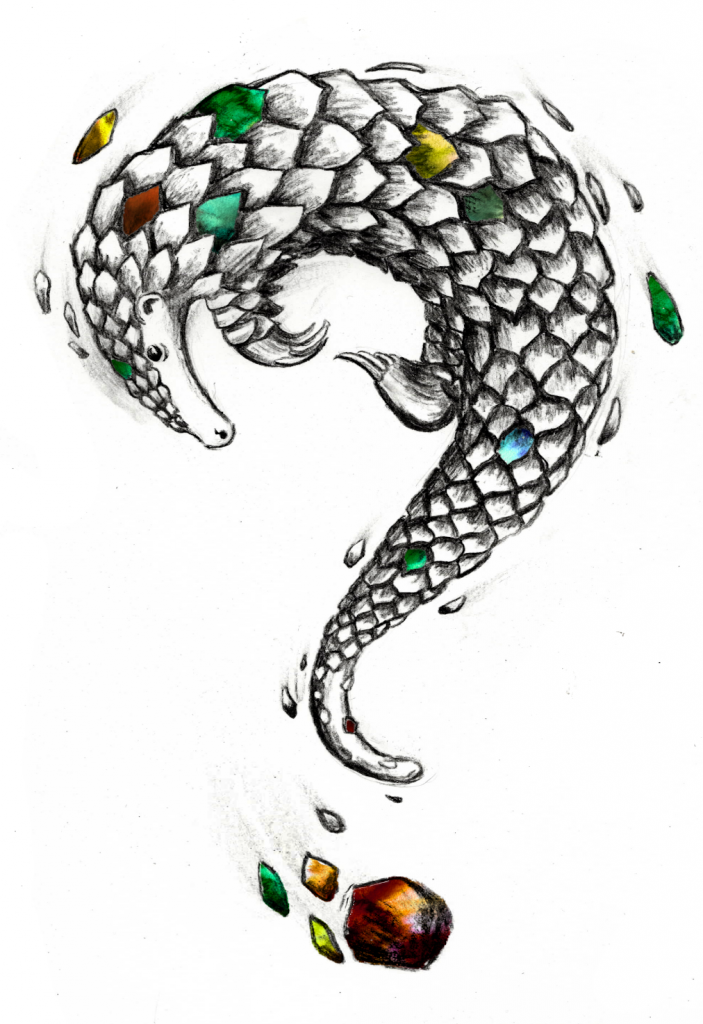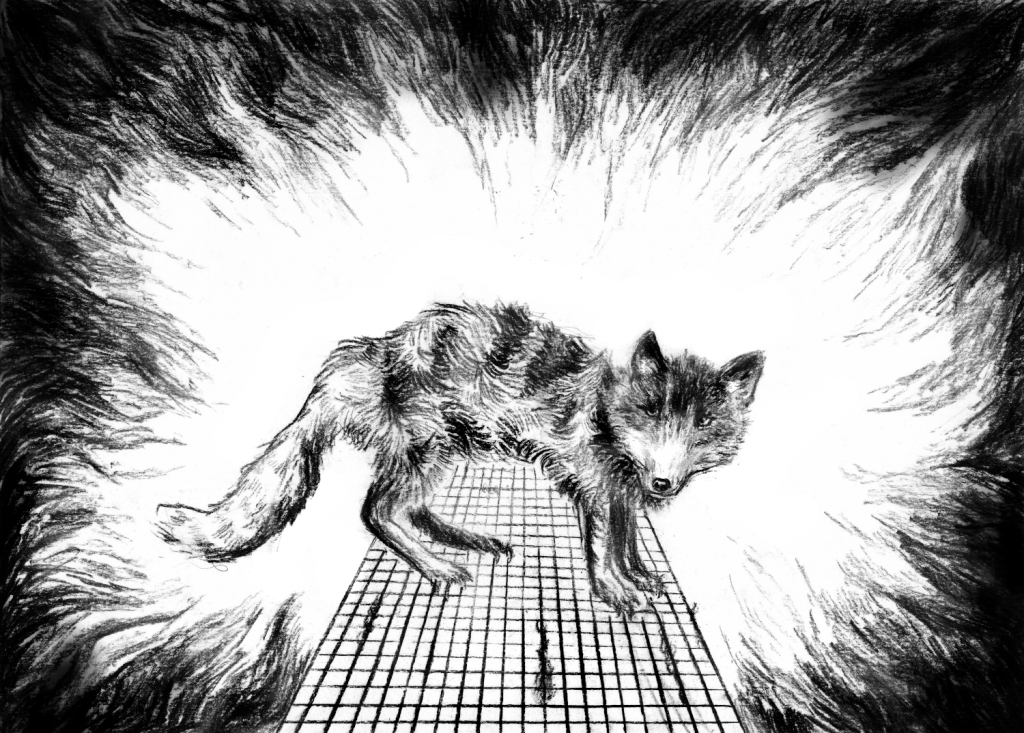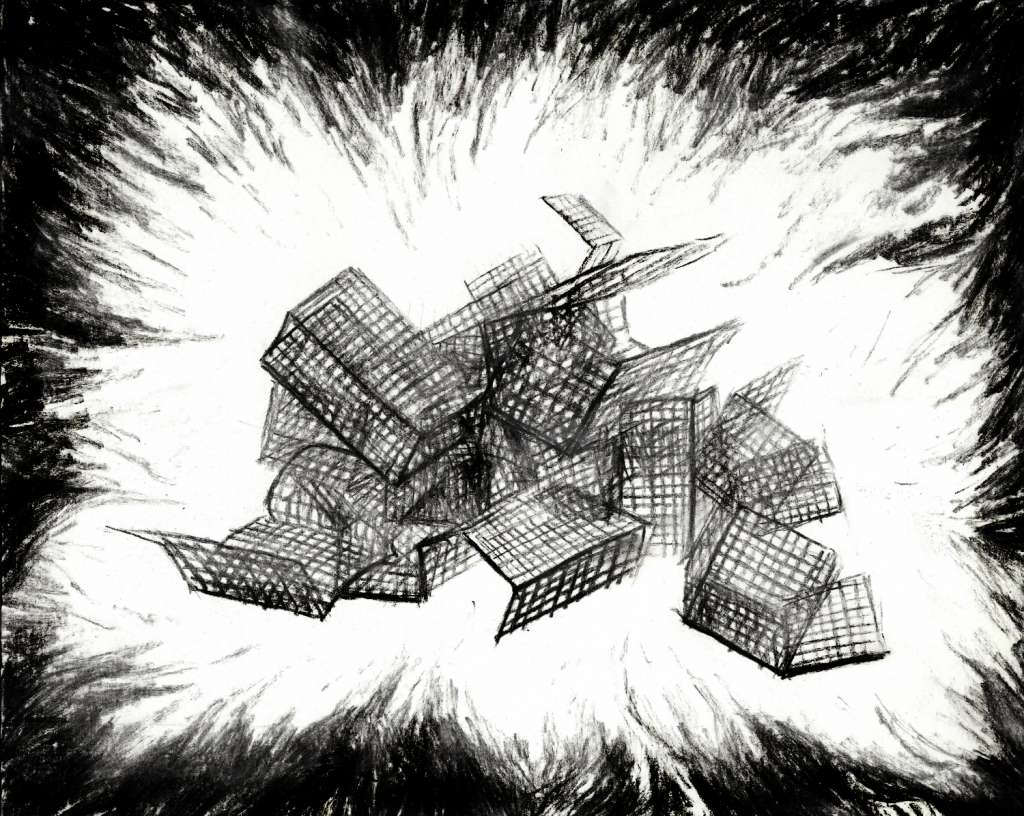Animal farming & COVID-19: from China’s wildlife trade to the European fur industry

We look at COVID-19’s potential origins in intensive animal farming, and how governments and the industry in China and Europe are responding to this. In view of the known links between factory farming and pandemics, we discuss the ongoing risk the industry presents to global health. This is part one of our two-part series on COVID-19 and the fur trade.
Summary
- The WHO is currently exploring the possibility that China’s wildlife farms may be at the origin of the COVID-19 pandemic. Others have more specifically suggested that the country’s lucrative fur industry is a likely source.
- Mink, the animals most widely-bred for their fur, are especially susceptible to contracting the disease and are the only species known to infect humans. Coronavirus cases have been reported across hundreds of European mink farms.
- The European and North American fur industries have been on the decline for years, with a number of major companies going bust. The mass culling of mink to stave off the spread of the virus in Europe and the resulting bans on fur production have hit the industry hard.
- Despite the risks posed by mink farming, China has done little to regulate its fur industry, which is the world’s largest. In fact, Chinese producers are making the most of the global fall in production and rising prices.
- Concerted efforts by lobbyists to rebrand the company as sustainable, and the recent announcement of a new mink vaccine may be sufficient to rescue Europe’s fur trade unless action is taken to shut it down for good.
- The risk of recurring pandemics in the near future remains high so long as toxic industries such as factory farming and the fur trade continue to exist.
Introduction
A WHO delegation to Wuhan has recently announced that Wuhan’s infamous seafood and live animal market, long presumed to have been the source of the COVID-19 pandemic, may merely have served as an early super-spreader event. One prominent theory the team is investigating is whether the virus in fact originated in China’s extensive network of wildlife farms before being carried to the market.
Wildlife farming involves the capture and breeding of wild animals for a broad variety of uses, including food, fur, medicine, experiments, the pet trade and entertainment. A 2017 report by the Chinese Academy of Engineering valued the industry at 520bn yuan, or £57bn.
It goes without saying that the conditions in the farms are hellish, with animals confined to tiny cages and deprived of all needs bar the minimum required to keep them alive. This industrial, 21st century effort to domesticate wild animals is seen as more cost-efficient and lucrative than trapping them in the wild, and has been subsidised by the Chinese government and promoted as a way to alleviate rural poverty.
If the farms were indeed the source of the virus, this would make COVID-19 just the latest disease suspected to have made the leap to humans through intensive animal farming.

Animal exploitation & pandemics: a brief history
Factory farming is one of the biggest risk factors for epidemics and pandemics. Reasons for this include overcrowded, stressed, poorly-nourished and selectively-bred animals with low genetic diversity; unhygienic conditions; the overuse of antibiotics; and the proximity of this population to humans. The risk of a virus successfully infecting a new species is increased with the degree of contact; therefore, animal agriculture heightens this risk.
Leading origin theories for some of the 20th century’s largest pandemics point the finger at animal farming.
The Spanish Flu, possibly the most deadly pandemic in modern history, has its origins in birds, and one leading hypothesis is that it emerged from North American poultry farms. Almost all cases of flu pandemics among humans – including some of the deadliest of the twentieth century – have been caused by descendants of the Spanish Flu virus, having mutated in pigs and poultry to produce new strains along the way. One form infected captive pig populations and later recombined with both human and avian flu to produce a new type of swine flu, which resulted in another pandemic in 2009.
SARS, a coronavirus responsible for a 2002-4 epidemic mainly in China, is believed to have originated in palm civets (also known as civet cats), which have been bred for meat and the production of an expensive coffee known as ‘Kopi Luwak’. The production of this coffee involves such cruelty that even its first importer to the West has since called for the end of the industry, yet it is still being sold to wealthy tourists in destinations such as Bali (in the UK, Harrods sells it for £500 per 250g bag). An alternative hypothesis, however, suggests that the roots of SARS lie in the Chinese fur industry.
MERS is a relatively new coronavirus which is far deadlier than COVID-19, but less transmissible, with cases having been mostly localised to Saudi Arabia. While the virus is still not fully understood, it is known to infect humans via camels, which are bred and farmed on the Arabian peninsula for milk, meat, leather and racing.
Meanwhile, the emergence of COVID-19 in China came fresh on the back of an epidemic of African Swine Fever, which resulted in the culling of over half of the country’s 440-odd million pigs. Although this particular virus does not affect people, a senior Russian epidemiologist has said that mutations which could lead to human infection are possible.
How new viruses emerge
New viruses tend to evolve in two ways:
Mutation: As a virus replicates, mutations can occur along the way. These can alter its characteristics, such as the severity of an infection. An accumulation of mutations can enable a virus to reinfect a host (for example a pig or human) since their antibodies fail to recognise its newest incarnation. These changes can also undermine vaccination programmes.
Recombination: This is when a host is simultaneously infected with two different viruses of the same family, leading to the production of unique viral offspring. So it may well be possible, for example, for a virus to emerge with the transmissibility of coronavirus and the lethality of MERS, if a host is infected with these viruses at the same time. Recombination can happen across species, with the risk being higher the greater the degree of contact.
Captive populations are ideal sites for recombination. A hypothesis under active investigation is that the virus that has caused the COVID-19 pandemic was the result of recombination between coronaviruses circulating among bats and pangolins, with the pangolin strain contributing the elements required to penetrate human cells. The 2009 Swine Flu pandemic is thought to have resulted from a complex recombination in pigs between two pig strains, an avian strain and a human strain. Pigs’ susceptibility to these different types of flu has led to them being called ‘mixing vessels’. However, since they are animals which are intensively farmed in appalling conditions the world over, the odds of them contracting multiple viruses simultaneously are high.
Mutation and recombination can both produce viral strains that have the ability to infect new species, such as that which gave rise to COVID-19.
China’s wildlife trade
Despite having encouraged the growth of wildlife farming in recent years, within the first few months of the pandemic, the Chinese government shut down almost 20,000 sites rearing animals for food. It issued a list of animals which from then on could be legally consumed. Off the list are bamboo rats, porcupines, peacocks and dogs. The government said that dogs could now only be considered pets, in accordance with the ‘progress of human civilisation’ and changing cultural values in China.
However, many animals can still be reared for consumption, including tortoises, ostriches, deer, crocodiles, salamanders, and numerous species that are extensively farmed in the UK and Europe. Meanwhile, the changes failed to curtail any other form of wildlife farming. The condition of the 10,000-odd bears kept on Chinese bear bile farms is likely to deteriorate since the government recommended bear bile as a treatment for coronavirus. Likewise, monkeys can continue to be captured and bred for medical research labs at home and abroad, with the COVID-19 vaccine quest increasing demand. China, along with Mauritius, is a leading exporter of monkeys for vivisection, supplying 80% of the tens of thousands of monkeys imported to the US prior to the pandemic.
Perhaps most noticeably, however, the changes do nothing to address the most lucrative form of wildlife farming: the fur trade. On the contrary, by classing mink, foxes and racoon dogs as ‘special livestock’, the changes only seal their fate.
COVID-19 & the Chinese fur trade
China is the world’s leading producer of fur, rearing over 40 million animals for their pelts in 2019. It is a sector worth 389 billion yuan (£43 billion) a year – that’s 75% of all the country’s wildlife farming. The number of fur farms in the country mushroomed in the 2000s, with European companies facilitating this by supplying mink for breeding and even running joint venture farms in China. And far from being shut down, the fur trade in China is now experiencing a pandemic-induced boom.
The French environmentalist publication, Reporterre, among others, suggests that the pandemic’s origins lie not just in China’s wildlife farms, but more precisely in its fur industry. Its investigation found:
- The three main species bred for fur in China (mink, foxes and raccoon dogs), are all highly susceptible to coronavirus.
- In the top mink farming region of Shangdong, the production of mink fur dropped dramatically by 55% in 2019 (from nearly 15 million mink pelts in 2018 to 6.5 million the following year). After being pressed on this, trade representatives claimed this was merely the result of market stagnation and overproduction.
- Mink have been inexplicably left out of studies on the origins of COVID-19.
- The fur industry may not only be the origin of COVID-19, but the source of the 2003 SARS outbreak too, as ‘China manoeuvred to incriminate the civet, a species of marginal economic importance’ and whose numbers are dwarfed by that of animals bred for their fur, ‘in order to divert attention from and protect the fur industry’.
It has been established that mink are particularly susceptible to coronavirus and transmit it easily among each other. In their recent report, the WHO names the animals as possible ‘intermediate hosts’ which first allowed the virus to spillover to humans; the other contenders are rabbits and raccoon dogs (both widely bred for their fur), pangolins, which are used in traditional medicine, and cats. It recommends that surveys be carried out on animals ‘bred for fur such as mink and racoon dogs’, since there has been a ‘massive’ undersampling of potential hosts. The report was followed by further criticism of the Chinese government’s obstruction and the the lack of access to full data.
Since mink are the only animals so far confirmed to be capable of transmitting the virus to humans, the Chinese government’s failure to thoroughly investigate and rein in its fur trade betrays its eagerness to protect its multi-billion pound industry.
While COVID-19’s full origin story remains inconclusive, scientists have nevertheless highlighted the risks of people being infected by captive or runaway mink, in particular, the threats that mink variants could pose to vaccine efforts. If there were strong reasons for shutting down parts of China’s wildlife industry, there are overwhelming reasons to shut down its fur farms.

COVID-19 & the European fur trade
In Europe, mink’s susceptibility to coronavirus has devastated the fur industry, with infections reported in over 400 of the continent’s 5,000 mink farms, as well as a number of significant mutations. Governments have responded with mass culls, including the slaughter of Denmark and the Netherlands’ entire mink populations. As the world’s top producer of mink pelts, this is ultimately expected to be the death knell of the Danish industry. In fact Kopenhagen Furs, which is the biggest fur auctioneer in the world and reportedly accounts for 40% of Denmark’s production, announced its closure within the next 2-3 years
Yet the industry was on the decline in Europe even before COVID-19 reared its head. Despite growth in demand for fur in the early 2010s, primarily driven by Chinese buyers, the expansion of Chinese mink farming and fall in fur prices had a major impact on European producers. By 2019, mink fur production in Europe and North America dropped 25% year-on-year, with some banks being unwilling to continue financing ailing businesses. In Poland, a major fur-producing country, a third of the country’s farms closed down between 2015 and 2020.
Since the start of the pandemic, public health concerns associated with mink farming have precipitated bans and suspensions in production across the continent. Europe’s fur industry is now on its way out, and it’s time to put the boot in once and for all.
New bans on fur production
In June 2020, the Netherlands announced all mink farms must close permanently by March 2021, bringing forward its phase-out plans by two years. Meanwhile Ireland is expected to ban mink farming by the end of the year, with the 120,000 mink on Ireland’s three remaining fur farms ordered to be culled.
Poland, the world’s third biggest fur producer, is in the process of passing a ban – although rabbits will be excluded from its scope. Similarly, Hungary announced a ban due to ‘animal welfare concerns’ and public health risks, but inexplicably excludes chinchillas.
In September, France declared an end to mink farming, yet is dragging its heels and wants to postpone the closure of its four remaining farms until 2025.
Denmark, Sweden, Belgium and Italy have all made more lacklustre announcements: mink farming will be suspended in these countries until 2022.
As we can see, the changes don’t spare all fur-bearing animals, and while the Chinese fur trade is horrific, many exposés by undercover activists shed light on equally harrowing scenes in European fur farms. These include cages littered with dead or dying animals, starvation, and cannibalism. Filthy conditions, sick and injured animals, cages barely large enough to move in, and animals driven to madness, aggression and self-mutilation are the norm.
Despite having banned fur production in the UK 20 years ago, rabbits are still farmed in the country, with fur being passed off as a mere ‘by-product’ of meat. Campaigners are currently fighting against one franchiser’s proposals to build more such farms in the UK.
Industry survival strategies: mink vaccines & greenwashing
As it clambers to maintain a foothold, the fight against the European fur industry is far from over. And its salvation may come in the form of a vaccine.
The Russian veterinary and agricultural agency Rosselkhoznadzor has just announced the creation of a successful vaccine for mink, foxes and other animals, known as Carnivak-Cov. Mass production expected to begin this month. Breeding facilities in various countries, including prominent fur producers such as Greece, were said to have ‘expressed interest’.
Meanwhile, the US firm Zoetis, which calls itself as the ‘largest global animal health company’, is still working on its own a vaccine for animals including mink. Medgene Labs, a much smaller US company, has also been developing a vaccine. If the mink coronavirus vaccines prove viable and affordable, they may be enough to rescue the decaying industry from its death throes.
Mink are already vaccinated against many diseases. In the US, fur farmers are said to be precariously dependant on just one vaccine supplier, United Vaccines, a US company which specialises in producing vaccines for the global fur trade.
The concerted efforts of fur industry representatives such as the International Fur Federation, Fur Europe and British Fur Trade Association over the years to promote fur as ethical, natural and sustainable are also likely to present further obstacles to change.
And while mass mink culls have taken place in Europe, ‘little action’ has been taken in China against its mink farms. In fact, the culls have caused the global price of fur to shoot up by a third, which has been fully taken advantage of by Chinese producers. The year’s events will likely leave China the world’s biggest producer of mink pelts, overtaking Denmark’s plummeting output. This only adds further credence to the theory that the state has been protecting the country’s fur trade and shielding it from the scrutiny of COVID-19 investigators.

The COVID-19 vaccines: why we can’t technofix our way out of a pandemic
The various human coronavirus vaccines now being used are likely to shield us from the worst of the disease. However, neither the human nor animal vaccines should signal a return to business as usual.
For one, the virus could evolve as it seeks to ‘get round’ the inoculation drive, meaning there is likely to be a sustained effort to develop vaccines that are effective against new strains for years to come.
The risks of mutation and recombination as the virus continues to infect captive populations, whether intensively-reared animals such as those held in the UK’s expanding network of megafarms, or humans kept in institutions such as prisons or detention centres, remain high. Various strains of COVID-19, as with other coronaviruses, are highly unlikely to just disappear. So long as there are vast pools of captive animals, viruses will simply continue to evolve – even if the original strain becomes less deadly.
This risk of mutation or recombination is particularly high as long as fur farms continue to operate, given mink’s susceptibility to the disease. Attempts to develop a vaccine for farmed mink are aimed at propping up an industry that may well be the origin of the pandemic. Capitalism has always seen animals as commodities and intensive farming is merely an extension of this mentality. As long as resources are injected into the survival of this system, our species is being committed to successive plagues, and we have no control over what form they will take, nor how deadly they will be.
Today, our species may be considered to be at the height of medical and technical skill, but we can’t break the current bind with more vaccinations, antibiotics and steroids – for either humans or livestock. Despite the staggering scientific advances of the past 200 years, the conditions that make us vulnerable to pandemics are arguably more present than ever: dramatic changes to ecosystems, and the massive growth in industrial animal farming.
By upsetting the balance, encroachment into wild spaces increases the risk of viruses and other pathogens infecting new animal species, while the growth in intensive animal agriculture provides the perfect environment for their leap to humans. The frequency of ‘spillover events’ in which pathogens jump from animals to humans, has doubled or even trebled in the past 40 years, and this has been linked directly with the conversion of forested areas to livestock production.
From ‘virus factories’ to a sustainable future
Following Denmark’s national mink cull, stories emerged of the animals resurfacing from their graves and contaminating the local groundwater. A striking metaphor perhaps for a toxic industry that needs to be laid to rest once and for all.
Many former wildlife farms in China are now being subsidised for conversion to other uses, such as mushroom-farming and brewing. Mushrooms are popping up, quite literally, in former cages where once sad and terrified wild animals were raised to be eaten. This must happen in fur farms too.
The European fur industry is slowly dying, it just needs a push. Recognising intensive animal farming as a major source of pandemics, particularly the vulnerability of mink farms to COVID-19, is the first step. Humane Society International is pushing a #FurFreeBritain campaign to ban the sale of fur countrywide, and there’s no better time to back this demand. But ending the industry in one part of the world will not safeguard us from future coronaviruses. It must be wiped out everywhere, along with all other forms of animal exploitation.
See here for part two of our series on the fur trade, which explores the marketing strategies used by the industry to maintain consumer demand, and maps the companies and lobbyists sustaining the fur trade in Britain and abroad.
Illustrations by Lanternfish.
